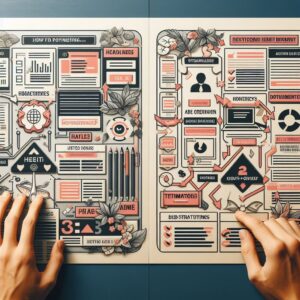They say you don’t get a second chance to make a first impression, and in the digital world, this is truer than ever. The first time a user lands on your website, they are forming an instant opinion of your brand, your products, and your professionalism. What factors influence this first impression? Primarily, web design. A well-thought-out and attractive web design can be the difference between a visitor who stays and one who leaves. In this article, we’ll explore how web design can influence your users’ purchasing decisions and how you can create an online experience that turns them into loyal customers.
The importance of first impressions in the digital world
In the digital age, competition is fierce and users are constantly bombarded with information. Capturing their attention in the first few seconds is crucial. A well-executed web design not only catches the user’s eye but also conveys a clear and concise message about your brand.
What elements influence the first impression?
- Visual design: The overall aesthetics of your website, including color palette, typography, images, and page layout, play a fundamental role. A clean, modern, and consistent design conveys professionalism and trust.
- Usability: A website that is easy to navigate and with a logical structure makes it easy for users to find what they are looking for. Usability is key to reducing bounce rates and increasing the time users spend on your site.
- Loading speed: A slow website can frustrate users and cause them to leave your page. Loading speed is a critical factor for user experience and SEO.
- Relevant content: The content on your website should be clear, concise, and relevant to your target audience. Quality content will help you position yourself as an expert in your industry and build trust.
- Clear calls to action: Calls to action (CTAs) should be visible and persuasive. They should clearly tell the user what action you want them to take, whether it’s buying a product, subscribing to a newsletter, or contacting you.
How to create a web design that converts
- Know your audience: Before you start designing your website, it’s essential to know your target audience. Who are your ideal customers? What are their needs? What motivates them?
- Define your brand: Your web design should reflect your brand identity. What are your company’s values? What is your tone of voice?
- Prioritize the user experience: Put the user at the center of everything. Design a website that is easy to navigate and offers a positive experience.
- Use a responsive design: Make sure your website adapts to any device, from desktops to smartphones.
- Invest in good images: High-quality images can significantly improve the look of your website and convey emotions.
- Simplify navigation: A clear and concise navigation menu makes it easy for users to find what they’re looking for.
- Include customer testimonials: Testimonials from satisfied customers can increase your brand’s credibility.
- Optimize for mobile: More and more people use their mobile phones to browse the internet, so it’s essential that your website is optimized for mobile devices.
- Conduct A/B tests: A/B testing allows you to compare different versions of your website to identify which elements work best.
The power of psychology in web design
Web design is not just an aesthetic matter, but also a psychological one. Colors, typography, and the arrangement of elements can influence users’ emotions and behavior.
- Colors: Colors evoke emotions and can influence purchasing decisions.
- Typography: The choice of typography can convey different sensations, from formality to informality.
- White space: White space helps create a clean and uncluttered design, making content easier to read and understand.
- The principle of visual hierarchy: Visual hierarchy guides the user’s attention to the most important elements of the page.
Expanding the Section: The Impact of Web Design on Sales Conversion
- Psychology of color and emotions: Analyze how different colors influence purchasing decisions. For example, red is often associated with urgency and passion, while blue conveys calmness and trust.
- Persuasive design: Explore persuasive design techniques, such as the scarcity principle (limiting product availability) or the authority principle (using expert testimonials).
- Microinteractions: Explain how small animations and interactive details can enhance the user experience and increase conversions.
- A/B testing: Delve into how A/B testing can help you optimize your web design and continuously increase conversions.
Example:
Red, for example, is often associated with urgency and passion. If you have a limited-time promotion, using this color in your call to action can encourage users to make an immediate purchase. On the other hand, blue conveys calmness and trust, making it ideal for websites of companies that offer professional services.
The Latest Trends in Web Design
- Minimalist design: Explore how minimalism has become a popular trend in web design, and how it can improve the user experience.
- User-centered design: Discuss the importance of designing with the user in mind, using tools like heatmaps and usability testing.
- Smooth animations and microinteractions: Analyze how smooth animations and microinteractions can enhance the user experience and make your website more engaging.
- Responsive design: Delve into the importance of responsive design, which allows your website to adapt to any device and orientation.
Example:
Minimalist design has become increasingly popular in recent years, as it allows content to stand out and facilitates navigation. By removing unnecessary elements, the user can focus on what really matters: your message and your offer.
The Importance of Accessibility in Web Design
- WCAG: Explain what the Web Content Accessibility Guidelines (WCAG) are and why they are important.
- Benefits of an accessible website: Discuss the benefits of creating a website that is accessible to all users, including people with disabilities.
- Key elements of accessibility: Cover topics such as color contrast, font sizes, alternative text for images, and keyboard navigation.
Example:
By making your website accessible, you are not only complying with regulations but also expanding your audience. An accessible website can be used by people with visual, auditory, motor, or cognitive disabilities.
How to Use Social Media to Promote Your Website
- Social media integration: Explain how to integrate social media into your website to increase interaction and traffic.
- Content marketing: Discuss how to create valuable content for your social media channels and attract new visitors to your website.
- Social media advertising: Analyze the different social media advertising options and how you can use them to reach your target audience.
Example:
Social media is an excellent way to connect with your audience and share relevant content. By integrating your social profiles into your website, you can make it easy for users to share your content and connect with you on other platforms.
Web Design and Storytelling
- The importance of storytelling: Explain how storytelling through web design can create an emotional connection with users.
- Narrative elements in web design: Discuss how to use elements such as typography, images, and page layout to tell a story.
Example:
By telling a story through your web design, you can make your brand more memorable and create an emotional connection with your users. For example, you can use images and videos to showcase the history of your company and how your products or services can help your customers.
Conclusion
A well-designed web design can make the difference between the success and failure of your online business. By investing in an attractive, functional and user-focused web design, you will be increasing your chances of converting your visitors into loyal customers.


